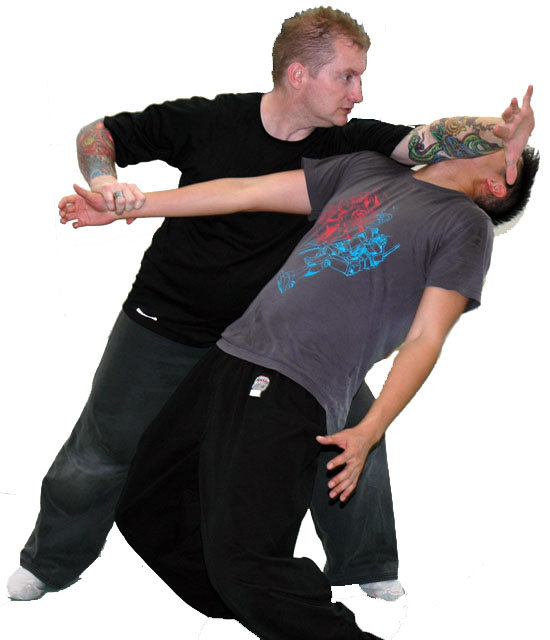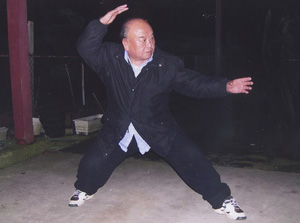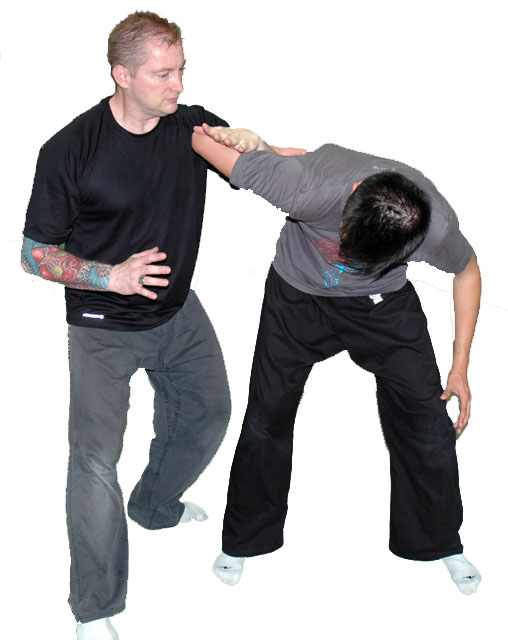about bagua zhang
 Bagua is a circular style of chinese martial art – it’s main assets are dissolving and mobility. While some styles of martial art attempt to block/stop/swat an attack, bagua’s focus is to ‘disappear’ through footwork and positioning, often resulting in the bagua fighter’s new position being at the point of origin of the originator’s attack or simply adding momentum to the attack where the attacker now becomes reliant upon the bagua fighter for balance and positioning. The chinese term ‘shun’ (which loosely implies ‘paddle with the flow of the water’) is prevalent in many bagua techniques, while the term ‘qiang’ (which implies opposing the flow of water – paddling upstream) is seldom adopted. Bagua has no high kicks – the legs are for rooting, mobility and low attacks. Bagua is often refered to as ‘guerilla warfare’ – there are no rules to protect a fighter from injury, and silent, unseen (and unfair) attacks are always the preference over sport based or obvious attacks. Locks, throws, takedowns, breaks, tendon separation and cavity press/strike prevails.
Bagua is a circular style of chinese martial art – it’s main assets are dissolving and mobility. While some styles of martial art attempt to block/stop/swat an attack, bagua’s focus is to ‘disappear’ through footwork and positioning, often resulting in the bagua fighter’s new position being at the point of origin of the originator’s attack or simply adding momentum to the attack where the attacker now becomes reliant upon the bagua fighter for balance and positioning. The chinese term ‘shun’ (which loosely implies ‘paddle with the flow of the water’) is prevalent in many bagua techniques, while the term ‘qiang’ (which implies opposing the flow of water – paddling upstream) is seldom adopted. Bagua has no high kicks – the legs are for rooting, mobility and low attacks. Bagua is often refered to as ‘guerilla warfare’ – there are no rules to protect a fighter from injury, and silent, unseen (and unfair) attacks are always the preference over sport based or obvious attacks. Locks, throws, takedowns, breaks, tendon separation and cavity press/strike prevails.
About Yang Guotai

Yang Guotai was born in Beijing in the early 1920s. He began his kungfu training at the age of 7, began training bagua at the age of 12 and at the age of 19 began training at the Beijing School of Bagua under his instructor Xu Zhenbiu. Yang Guotai trained under Xu Zhenbiu and other Bagua masters at the Beijing School of Bagua until his early 60s at which point Master Xu had passed away. Shortly thereafter Yang Guotai moved to Vancouver, BC and began his search for students to pass his knowledge onto. Yang Guotai loved bagua - he invested his life into it - and his love of bagua was expressed in teaching his students the skills that he passed on to them.
About Cheng Shi Bagua Zhang
Cheng Shi Bagua Zhang (cheng style 8 trigram palm) is based on the teachings of Cheng Ting Hua. Cheng Ting Hua was a skilled Chinese Wrestler who began studying Bagua Zhang under Master Dong Hai Quan – purported to be the founder of Bagua Zhang. Cheng Ting Hua’s skill was well recognized as he had fought and beaten many challengers.
Unlike other students of Dong Hai Quan, Cheng Ting Hua enjoyed teaching his many students which makes Cheng Style Bagua (Cheng Shi Bagua in chinese) one of the more prevalent systems of Bagua Zhang today.
Cheng Shi Bagua Zhang generally consists of 8 basic palms (xiao ba zhang – small 8 palms), 8 mother palms (ba mu zhang or da ma zhang – big 8 palms) and 64 hands (liu shi si shou) – often called ’64 palms’.
about our classes
Lineage: Cheng Ting Hua -> Liu Bin -> Xu Zhen Biao -> Yang Guo Tai -> Dave Meikle
At North Vancouver Bagua School the classes are taught in a more hands-on approach (2 person fighting drills) – we feel this lends itself to a more practical application of Bagua Zhang. This is not a contemporary wushu school. While there are forms that can be taught, most of the classes are based on partner drills and the learning of applications – forms are more of a supplement to training. Conditioning exercises are also emphasized in each class – this can sometimes be slightly uncomfortable, so it is recommended that you begin lightly and gradually increase intensity as your body develops.
The purpose of partner training is not about ‘I want to break my partner’ – in fact we don’t allow people like that to join our club. Good partner training encourages trust – more trust means your partner will allow himself to expose more openings for you to take advantage of during training, which in turn pays off by letting you have clearer attacks to execute. The key is commeraderie.
All of our classes are self defense classes. Unlike schools that focus on hand forms or weapons forms every class involves take downs, throws, strikes and locks. This is the difference between practising (memorization of forms) and training (developing the skill to use your fighting methods in real self defense). We are not the only school teaching realistic self defense – there are some good ones out there. But it’s important to know the difference between a self defense school and a wushu school that teaches primarily forms with application as an afterthought.

Women's Self Defense
Since all of our classes are self defense based there is no "women's only self defense" - the women are treated as equals here and are paired up with all fellow classmates in regular 'round robin' training - this means they're going to get locked, thrown and controlled like all of their classmates regardless of gender. This prepares women for the inevitable possibility that their attacker may be a man and develops the confidence that the techniques DO work on someone possibly much stronger. This is possible since the techniques taught are based on principles of balance, controlling your opponent's balance, and attacking weak areas from specific positioning of the body - there is no muscular requirements to overcome an opponent. Obviously in the beginning the techniques applied are done so in a much gentler fashion until proper conditioning is acquired, but this is also done for our male students as well. None of the self defense techniques require any strength whatsoever - and in many cases the stiffer the opponent the easier to apply the application - or the more reason to strike a much more vulnerable area!